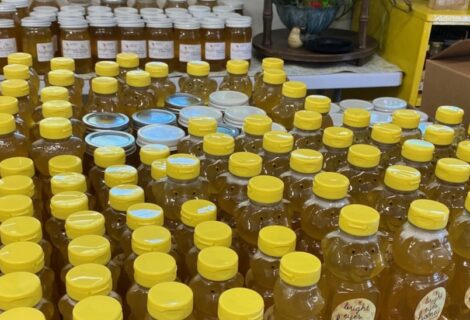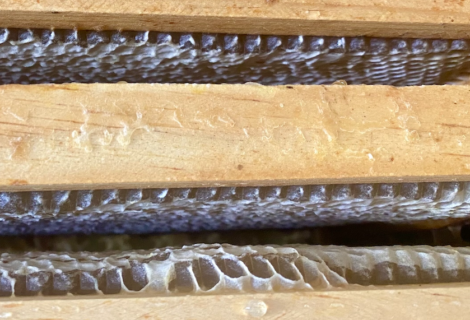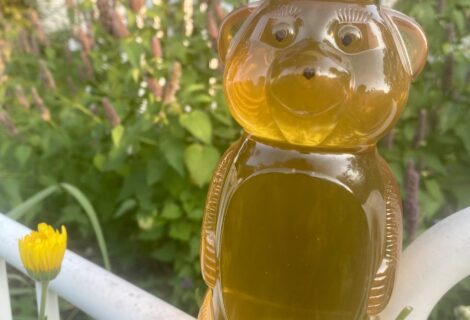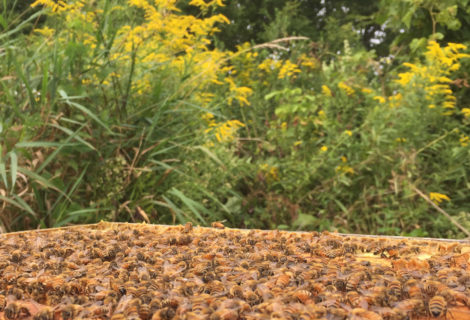Honey Harvest Photo Highlights
Here are some photo highlights of the process, starting with adding the bee escapes last Thursday afternoon/evening. Bee escapes are thin inserts to place in the hive stack right below the honey supers that we plan to take off the following day. The bees can travel down through the ‘maze’, but have trouble finding the small exits from the ‘escapes’ in order to go back up into the honey supers. That way, they are mostly free & clear of bees when we go to remove the boxes the following day.

A view of some hives from blooming thistles with a field of golden rod behind me (that you cannot see).
On Friday, we started pulling the honey supers off. They are heavy with golden goodness. Again, this year, we used a leaf blower to give the few remaining bees a quick exit.

We had another bee escape to put on Friday, and this photo shows the difficulty of putting a hive back together that is full of bees. There is a bunch hanging from the bottom of that box that I’m trying to avoid having crushed by scraping them off to the outside front of hive.

Last year, we used a trailer to put the honey supers on, but this time my dad made a nice platform from an old building door sitting on bale mover (two large fork tines) with hydraulic lift.
Also, on Friday, we starting putting together a “warming wall” for the supers. It has a solid bottom made of 2x6s that can support a lot of weight. Within the bottom, we can put a small space heater and a desk fan to circulate heat into the stack of supers above.

Also made a “hood” for the top to trap the heat inside the wall. Had a small USB fan inside the hood as well. Here the hood is upside down as my dad adds some wire handles.

The completed warming wall in our garage. There are only a couple “blanks” in the stack, otherwise most of those boxes are decently full of honey.

I used a long probe thermometer inserted into drilled holes to periodically monitor the temperature in different locations.
We started the warming process Saturday evening, and we began extracting on Monday morning. I found out that we could have let the warming go on another two days to really allow the honey supers to absorb the heat, especially on top. The bottom two rows were perfect as far as wax warmth and being able to ‘uncap like butter’.
Also, on Saturday I went back to inspect some hives and remove a few bee escapes and queen excluders. I needed to make sure that certain hives had enough honey feed remaining. One was in dire straights already in that it hadn’t stored much in its bottom brood boxes, so I added back a super of honey two it. Also gave some frames to a few other colonies. I saw a few other interesting things in a couple colonies that I’ll try to blog about later.
In the photo below, what you see is several layers of bees clinging to the underside of a bee escape after lifting it off the hive and placing it before the front hive entrance.
Monday morning at 7:45 began the extraction process.

Moses and the new extractor I borrowed from a co-worker this year. It worked well – 6 frames at a time, radially spinning, with a variable speed motor. In the background is “Baba” with camera, Jana at the bottling station, and Ann Martin at the labeling station. Ann also ran the extractor all afternoon following Moses’ departure. Thanks Ann! Though not pictured here, we give a big thanks as well to Amy Moreland and Wendy Speary for their help with labeling and the process in general.

Aidan gets in on a little taste-testing action with the rest of the gang. The kids got to quite a bit of tasting, or what we like to call “cleanup” over the next few days.

Raw honey on tap. We like honey gates! We were able to rotate between two 5 gallon buckets this year.

We were joined by some dear friends from Zimbabwe in the afternoon – Fanny & Martha! They were a big help. We had two uncapping stations going in parallel all day.
We finished extracting a little after dinner in the evening. We are very blessed! You can place your order here before it is gone. The shelves are literally much barer just a few days after the above photo was taken.















Recent Comments